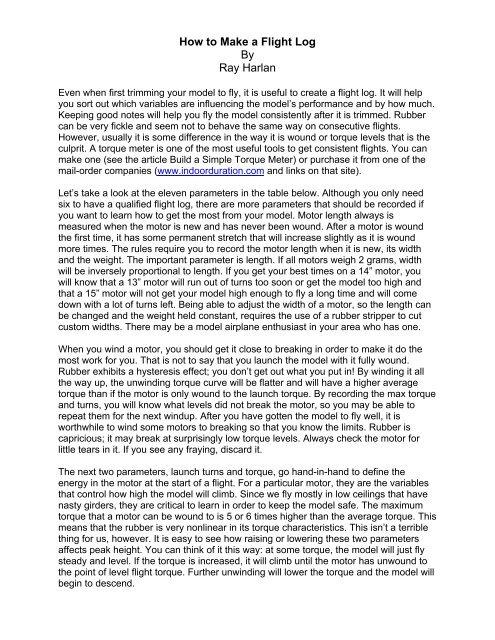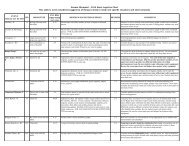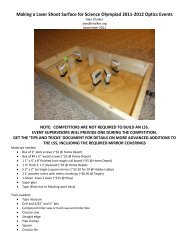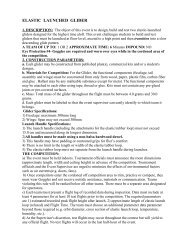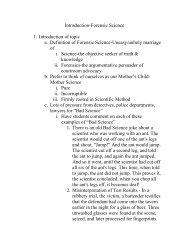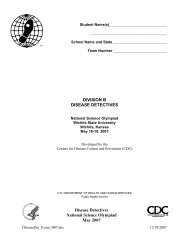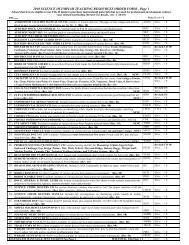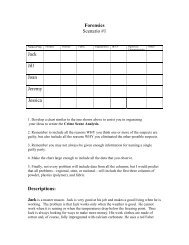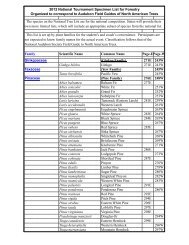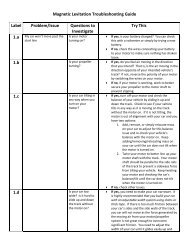How to Make a Flight Log By Ray Harlan
How to Make a Flight Log By Ray Harlan
How to Make a Flight Log By Ray Harlan
- No tags were found...
You also want an ePaper? Increase the reach of your titles
YUMPU automatically turns print PDFs into web optimized ePapers that Google loves.
<strong>How</strong> <strong>to</strong> <strong>Make</strong> a <strong>Flight</strong> <strong>Log</strong><strong>By</strong><strong>Ray</strong> <strong>Harlan</strong>Even when first trimming your model <strong>to</strong> fly, it is useful <strong>to</strong> create a flight log. It will helpyou sort out which variables are influencing the model’s performance and by how much.Keeping good notes will help you fly the model consistently after it is trimmed. Rubbercan be very fickle and seem not <strong>to</strong> behave the same way on consecutive flights.<strong>How</strong>ever, usually it is some difference in the way it is wound or <strong>to</strong>rque levels that is theculprit. A <strong>to</strong>rque meter is one of the most useful <strong>to</strong>ols <strong>to</strong> get consistent flights. You canmake one (see the article Build a Simple Torque Meter) or purchase it from one of themail-order companies (www.indoorduration.com and links on that site).Let’s take a look at the eleven parameters in the table below. Although you only needsix <strong>to</strong> have a qualified flight log, there are more parameters that should be recorded ifyou want <strong>to</strong> learn how <strong>to</strong> get the most from your model. Mo<strong>to</strong>r length always ismeasured when the mo<strong>to</strong>r is new and has never been wound. After a mo<strong>to</strong>r is woundthe first time, it has some permanent stretch that will increase slightly as it is woundmore times. The rules require you <strong>to</strong> record the mo<strong>to</strong>r length when it is new, its widthand the weight. The important parameter is length. If all mo<strong>to</strong>rs weigh 2 grams, widthwill be inversely proportional <strong>to</strong> length. If you get your best times on a 14” mo<strong>to</strong>r, youwill know that a 13” mo<strong>to</strong>r will run out of turns <strong>to</strong>o soon or get the model <strong>to</strong>o high andthat a 15” mo<strong>to</strong>r will not get your model high enough <strong>to</strong> fly a long time and will comedown with a lot of turns left. Being able <strong>to</strong> adjust the width of a mo<strong>to</strong>r, so the length canbe changed and the weight held constant, requires the use of a rubber stripper <strong>to</strong> cutcus<strong>to</strong>m widths. There may be a model airplane enthusiast in your area who has one.When you wind a mo<strong>to</strong>r, you should get it close <strong>to</strong> breaking in order <strong>to</strong> make it do themost work for you. That is not <strong>to</strong> say that you launch the model with it fully wound.Rubber exhibits a hysteresis effect; you don’t get out what you put in! <strong>By</strong> winding it allthe way up, the unwinding <strong>to</strong>rque curve will be flatter and will have a higher average<strong>to</strong>rque than if the mo<strong>to</strong>r is only wound <strong>to</strong> the launch <strong>to</strong>rque. <strong>By</strong> recording the max <strong>to</strong>rqueand turns, you will know what levels did not break the mo<strong>to</strong>r, so you may be able <strong>to</strong>repeat them for the next windup. After you have gotten the model <strong>to</strong> fly well, it isworthwhile <strong>to</strong> wind some mo<strong>to</strong>rs <strong>to</strong> breaking so that you know the limits. Rubber iscapricious; it may break at surprisingly low <strong>to</strong>rque levels. Always check the mo<strong>to</strong>r forlittle tears in it. If you see any fraying, discard it.The next two parameters, launch turns and <strong>to</strong>rque, go hand-in-hand <strong>to</strong> define theenergy in the mo<strong>to</strong>r at the start of a flight. For a particular mo<strong>to</strong>r, they are the variablesthat control how high the model will climb. Since we fly mostly in low ceilings that havenasty girders, they are critical <strong>to</strong> learn in order <strong>to</strong> keep the model safe. The maximum<strong>to</strong>rque that a mo<strong>to</strong>r can be wound <strong>to</strong> is 5 or 6 times higher than the average <strong>to</strong>rque. Thismeans that the rubber is very nonlinear in its <strong>to</strong>rque characteristics. This isn’t a terriblething for us, however. It is easy <strong>to</strong> see how raising or lowering these two parametersaffects peak height. You can think of it this way: at some <strong>to</strong>rque, the model will just flysteady and level. If the <strong>to</strong>rque is increased, it will climb until the mo<strong>to</strong>r has unwound <strong>to</strong>the point of level flight <strong>to</strong>rque. Further unwinding will lower the <strong>to</strong>rque and the model willbegin <strong>to</strong> descend.
Finding the right launch <strong>to</strong>rque should be done in steps. If the model climbs halfway upwith 1200 turns, add only 100 turns <strong>to</strong> the next flight. Notice that the <strong>to</strong>rque goes upmuch more than the 8% you increased the turns. This time, the model might go threequarters of the way up. Succeeding flights should have turns increased by smallerincrements until the model just <strong>to</strong>uches the girders once or twice (or maybe not at all ifthey catch models easily).It is important <strong>to</strong> know how <strong>to</strong> wind a mo<strong>to</strong>r <strong>to</strong> get the most out of it. To get the mostturns, it needs <strong>to</strong> be lubricated and stretched. Use a lube like ArmorAll or Formula 2001,found in au<strong>to</strong> parts s<strong>to</strong>res. After some of the liquid has evaporated, they get nice andgreasy <strong>to</strong> keep the rubber from chafing on itself. Stretch the mo<strong>to</strong>r about 6 feet and puthalf of the turns in at that distance. Then continue winding and moving closer <strong>to</strong> theother end of the mo<strong>to</strong>r until it is about 12” long when fully wound. Of course you don’tknow what max turns are, so it is clear you need <strong>to</strong> wind the mo<strong>to</strong>r several times andultimately break it so you can find out how much it takes.Once you have gotten the model <strong>to</strong> reach the ceiling, it is time <strong>to</strong> fine tune the mo<strong>to</strong>rused. Every time it lands, put the winder back on the rear of the mo<strong>to</strong>r and count howmany turns are left. This is a good clue in choosing the right mo<strong>to</strong>r. If the rubber hasonly a few turns, or it ran out of turns in the air, the mo<strong>to</strong>r is <strong>to</strong>o short and you needmore turns. If it comes down from the ceiling with 700 or more turns, the mo<strong>to</strong>r is <strong>to</strong>olong. Ideally, the average <strong>to</strong>rque should be near that needed for level flight. Findingaverage <strong>to</strong>rque is complex and not really needed. Instead, just experiment with differentlength mo<strong>to</strong>rs until you find the one that gets the best time. In a low ceiling (20 – 30 ft.),250 <strong>to</strong> 500 turns at landing may be about right.As a mo<strong>to</strong>r is used for more flights, it will take some more turns <strong>to</strong> get <strong>to</strong> the max <strong>to</strong>rque.Most of this energy is seen at the end of rundown and is not useful. The important thingis <strong>to</strong> wind <strong>to</strong> the same peak <strong>to</strong>rque each time. After each flight, inspect the rubber fornicks or fraying. Discard any that are damaged.You can measure the height of your flying site with a balloon on a string. Let the balloon<strong>to</strong>uch the girders and use a tape measure <strong>to</strong> find the length of the string and balloonafter it is pulled down parallel <strong>to</strong> the floor. Proportioning this height (1/2, 3/4, 7/8 etc.)gets you the peak height entry in the log.Measure off 20 feet on the floor and mark both ends with tape. Start with a heel at thefirst mark and walk naturally <strong>to</strong> the second mark, counting steps as you go. Divide 20 bythe number of steps <strong>to</strong> get your step length. When your model is flying, stand under it asit flies by and start walking <strong>to</strong> the other side of the circle in which it is flying. Count thesteps and multiply by the length of your step <strong>to</strong> get the circle diameter. Models shouldfly in small circles (10 -15 ft) in small sites and larger circles (20 - 30 ft) in larger sites. Ifthe circle is small and the model is banking a lot, it needs <strong>to</strong> be retrimmed, perhapsadding left wing washin (twist trailing edge down), removing some left rudder and leftthrust. In a site with a peaked roof, a small circle lets the model climb higher and if itdoes hit a girder and the circle moves, it has less chance of getting in<strong>to</strong> trouble.It should be clear by now that the parameters listed in the flight log are very useful forimproving flights as you build up experience with your model. There are lots more thingsthat could be recorded, but these are the most important ones. Lots of practice willmake you a better flier, able <strong>to</strong> find the best settings in a new flying site at a regional orstate meet much faster than someone who just finished a model the night before.
Mo<strong>to</strong>r length (new)Mo<strong>to</strong>r width (new)Mo<strong>to</strong>r weightMax turnsMax <strong>to</strong>rqueLaunch turnsLaunch <strong>to</strong>rqueTurns at landing<strong>Flight</strong> timePeak heightCircle diameter<strong>Flight</strong> 1 <strong>Flight</strong> 2 <strong>Flight</strong> 3 <strong>Flight</strong> 4 <strong>Flight</strong> 5Mo<strong>to</strong>r length (new)Mo<strong>to</strong>r width (new)Mo<strong>to</strong>r weightMax turnsMax <strong>to</strong>rqueLaunch turnsLaunch <strong>to</strong>rqueTurns at landing<strong>Flight</strong> timePeak heightCircle diameter<strong>Flight</strong> 1 <strong>Flight</strong> 2 <strong>Flight</strong> 3 <strong>Flight</strong> 4 <strong>Flight</strong> 5Mo<strong>to</strong>r length (new)Mo<strong>to</strong>r width (new)Mo<strong>to</strong>r weightMax turnsMax <strong>to</strong>rqueLaunch turnsLaunch <strong>to</strong>rqueTurns at landing<strong>Flight</strong> timePeak heightCircle diameter<strong>Flight</strong> 1 <strong>Flight</strong> 2 <strong>Flight</strong> 3 <strong>Flight</strong> 4 <strong>Flight</strong> 5


